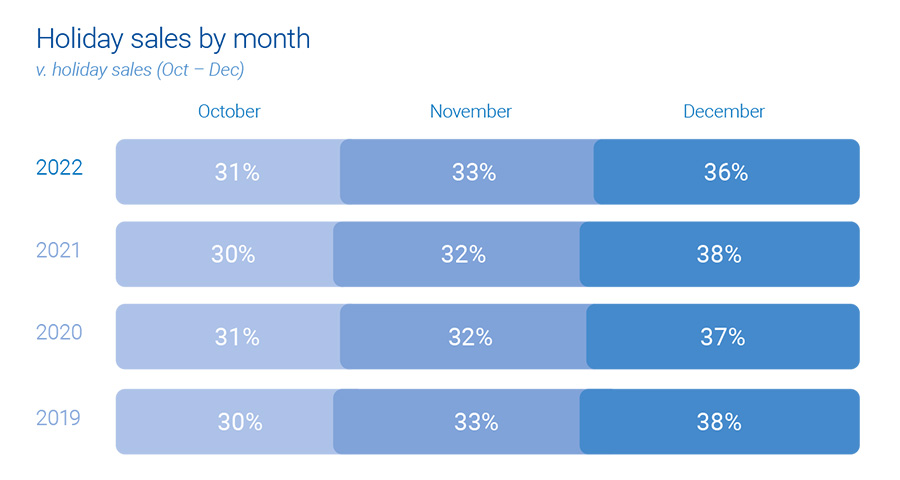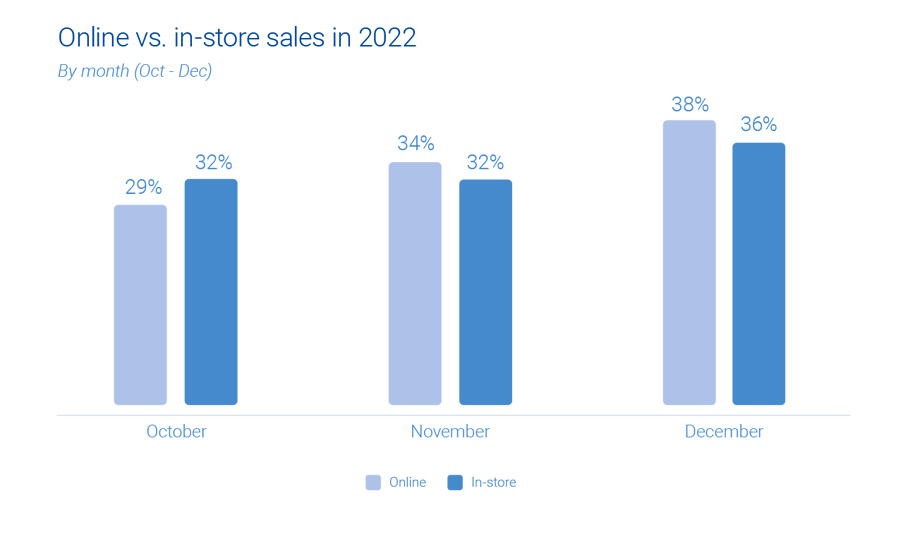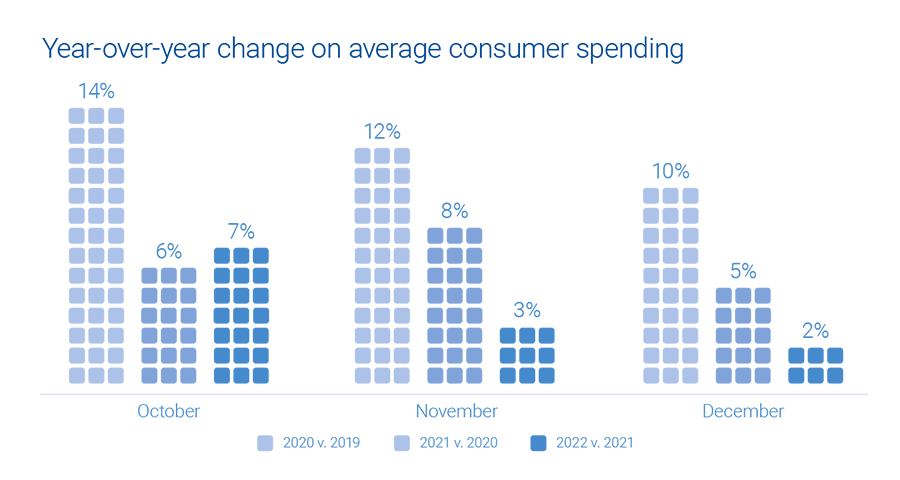
The holiday season is just around the corner, and retailers and marketers are gearing up for the busiest shopping period of the year. It’s crucial to understand how consumer behavior is evolving and what emerging trends to expect. Experian’s 2023 Holiday spending trends and insights report analyzes recent trends, consumer spending habits, and anticipates what’s to come in 2023 to help you deliver a top-notch shopping experience this holiday season.
In this blog post, we’ll cover three key insights from our report.
1. Consumers are shopping earlier
It’s no secret that December has always been the go-to month for consumers when it comes to holiday spending. However, holiday shopping now starts earlier, particularly with online sales.

This can be attributed to a surge in promotions and deals, enticing shoppers to open their wallets ahead of time, giving a significant boost to holiday sales. Notably, Cyber Week sales have proven to be an influential factor, accounting for 8% of total consumer holiday spending.
Experian tip
Reach the right shoppers with your promotions with sell-side targeting. This powerful approach gives you control over where your ads are placed while ensuring maximum visibility through direct connections with publishers. Whether on mobile, web, or CTV, this seamless ad experience will engage your audience effectively.
2. Online sales are on the rise
The popularity of online holiday sales is continuously growing, surpassing in-store shopping. There has been a consistent 1% year-over-year increase in online sales, while in-store sales have seen a 1% decrease.
“It’s easier for consumers to comparison shop for large ticket items online that they might find at a mass retailer or office supply store. Consumers prefer to have larger, bulkier items shipped directly to their home for minimal cost. By shopping online, consumers can save time since they don’t need to wait in checkout lines.”
Anna Liparoto, Sr. Account Executive, Retail & CPG

Although online sales currently make up only one-third of all holiday shopping, there is immense potential for further expansion. Mass retailers and office, electronics, and games industries particularly excel in online holiday sales. While in-store purchases remain the primary choice for holiday shoppers, consumer online and offline activities intersect before the final purchase.
Experian tip
Take advantage of the surge in online shopping by diversifying your marketing channels. An agnostic identity graph can bring together device and media data, capturing valuable user insights. By gaining a holistic view of your target audience, you’ll be able to optimize your ad spend and allocate resources effectively, ultimately boosting your return on investment.
“Omnichannel targeting during the upcoming holiday season will continue to prove to be the best way to reach scale and maximize ROI across all marketing channels.”
Joe LigÉ, Head of Enterprise Demand Partnerships
3. 2023 holiday spending will be on par with 2022
During the holiday season in 2022, consumer spending showed an anticipated increase, although the growth rate was slightly lower compared to previous years. October saw a surge in average consumer spending, indicating a swift response to early discounts and promotions offered by retailers.

As the holiday season progressed, holiday spending gradually slowed down and reached a level similar to that of the previous year. Overall, there was a modest 2% growth. Looking into the future, if economic conditions remain stable in the second half of 2023, we can expect holiday spending to align with the figures from last year.
Experian tip
To truly maximize impact, consider data enrichment. By diving deeper into your target audience’s preferences and behaviors, you can better tailor your strategies and seamlessly integrate the enriched data across various channels. This allows you to unlock the true potential of your ad inventory, creating more meaningful connections with your audience.
Download our 2024 report
Get ready for the holiday shopping season with Experian’s 2024 Holiday spending trends and insights report. Inside you’ll find:
- Analysis of past trends and what they mean for 2024
- Exclusive predictions for the upcoming holiday season
- The top audiences to activate this holiday season
To access to all of our predictions for this year’s holiday shopping season, download our 2024 Holiday spending trends and insights report today.
Latest posts

The holiday season is right around the corner and retailers are gearing up for a massive influx of customers, both new visitors and returning loyal patrons. But, organizations need to make sure they’re prepared to handle the influx of business. Data quality should be a priority for retailers at any time of year, but even more so as the holiday season approaches. During this time, it’s important for companies to provide customers with relevant shopping offers. When consumers shop for holiday gifts for their friends and families, they have countless directions to which they can turn. In order to prevail in competition, retailers need to provide customers with relevant offers and messages. Unfortunately, many businesses fall short in this regard. According to recent research from Experian QAS, organizations feel that, on average, 25 percent of their data is inaccurate. Consumers are frantically looking to find deals on products that meet their holiday needs, but loyalty offers may not be reaching consumers. One reason for the difficulty is the messy nature of companies’ customer databases. Retail businesses are working hard to gather as much information as possible about the consumers who patronize them, but all too often, information is riddled with errors. These errors have become more prevalent in recent years due to the proliferation of mobile apps, web interfaces and social media channels. There are so many different channels that companies now interact with people through an average of 3.27 channels. This poor data quality is hurting organizational bottom lines. Experian QAS found that an average of 12 percent of departmental budgets are wasted due to inaccuracies in contact data. During the 2013 holiday season, consumer spending is expected to increase by at least 11 percent. Retailers need to be certain that they improve data quality prior to the holiday season to ensure communications reach consumers and resources are maximized in order to take advantage of the expected increase. Be sure to check out our new data quality infographic.

Experian Marketing Services’ Head of Global Research Bill Tancer appeared recently on Fox Business News to talk about new holiday shopping trends, including why both retailers and consumers are starting the 2013 season earlier this year. “We are seeing the eventual extinction of Black Friday,” says Tancer. “What we see in our data is that retail is really changing. The consumer is relentlessly searching for that deal.” In fact, as Tancer notes, the hyper-connected, digital consumer is already searching for holiday deals. Hear more from Tancer in this clip. Watch the latest video at video.foxbusiness.com Tancer and other Experian Marketing Services data experts will discuss holiday marketing trends at an upcoming webinar; register for more insights and tips.

On some level, collecting data and analyzing it to find meaningful conclusions has always been part of how marketers go about connecting with consumers. Their strategies have improved dramatically over time, though. Perhaps in a previous era, marketing executives were only able to make sweeping generalizations about large swathes of the population. But, as marketers have gathered more data on individual consumers, they’ve found ways to fine-tune their searches. They’re no longer messaging to groups in vague terms. Smart Data Collective recently examined the marketing world’s transition away from broad stereotyping toward better targeted forms of data mining. Josh Brown, a member of the marketing team at business and IT consulting company Iconic Mind, argues that this era of overgeneralization is coming to an end. We now have the capability to zoom in on the specific customer. “Big data is how successful companies are building more detailed models of consumer behavior,” Brown wrote. “Instead of relying on the traditional demographic models that marketers used when we were operating in a mass consumption environment and had nothing better, big data capitalizes on developing market trends to allow businesses to become far more specific when segmenting their customers.” Brown cited Amazon.com as an example. The online superstore is notable for its targeted recommendations of products that shoppers see every time they log on to the site – the advisements are impressive because they’re usually right up the customer’s alley. Amazon doesn’t generate these ideas by making guesses based on whether the consumer is old or young, male or female – instead, the site takes in specific information about people’s buying histories and looks for similar products. This approach is quickly becoming mainstream. It’s not hard to understand why – people don’t like being reduced to profiles of their demographic characteristics. Consumers are expecting more from the companies they do business with. Thanks to the rapidly improving technologies that companies use for data collection, marketers can be more targeted and make more intelligent interactions. However, to take advantage of these new technologies, marketers need to maintain high quality data. Without a data quality strategy, customer information will be spread out across the organization, making it difficult to make intelligent marketing offers. To learn more about improving your understanding of consumers, check-out our infographic on building a single customer view.